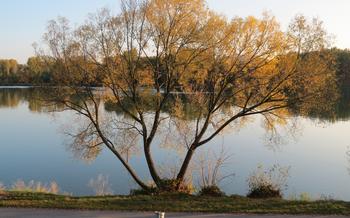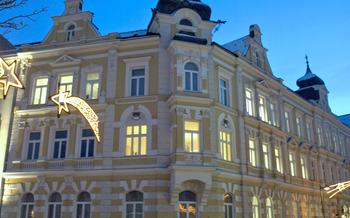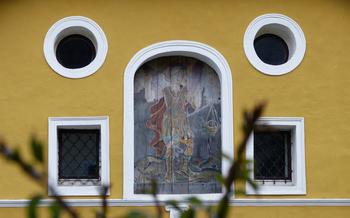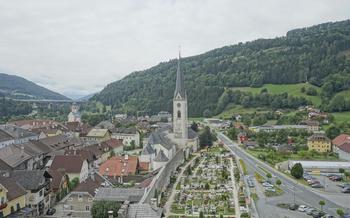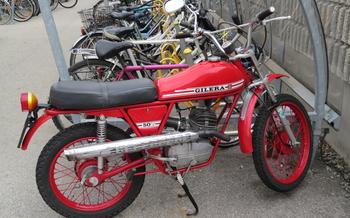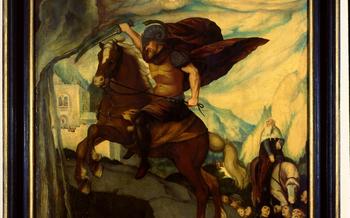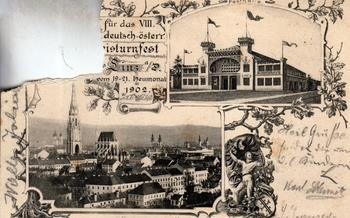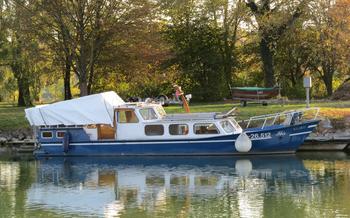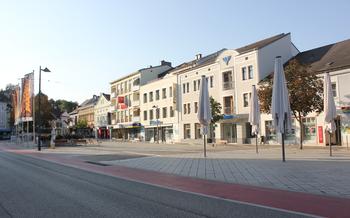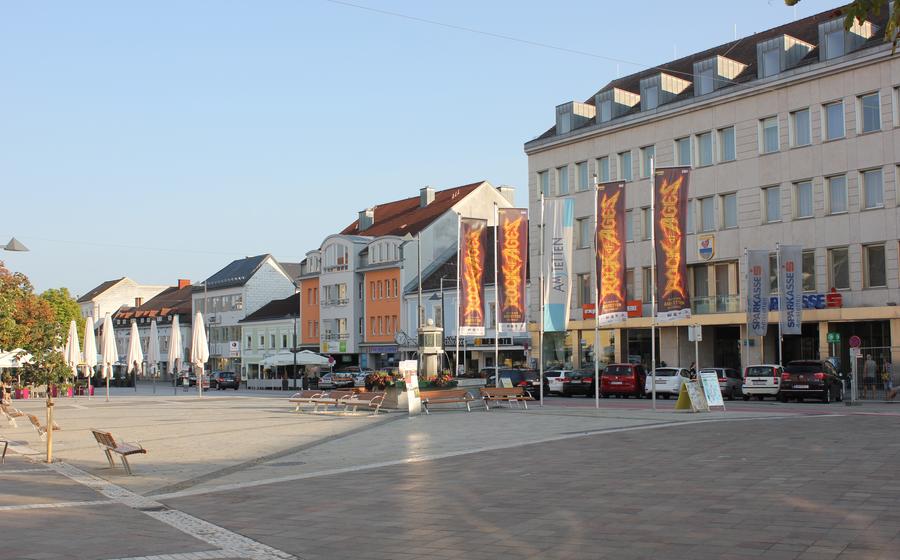
Waldviertel Railway
- History of the Waldviertel Railway
- Scenic Routes and Landscapes
- Nostalgic Steam Locomotives
- Unique Railway Experiences
- Waldviertel Railway Museum: A Journey Through History
- Local Culture and Traditions
- Hiking and Biking Trails
- Culinary Delights
- Photography Opportunities:
- Family-Friendly Activities
- Accessibility and Practical Information
- Sustainable Travel
- Insider Tip: A Hidden Gem Awaits
History of the Waldviertel Railway
In the heart of Austria's picturesque Waldviertel region lies a charming railway line, the Waldviertel Railway, steeped in history and natural beauty. Its origins date back to the late 19th century when the need for efficient transportation in the region became apparent. In 1872, the Gmünd-Waidhofen an der Thaya section was constructed, followed by the completion of the entire line to Groß Gerungs in 188
The Waldviertel Railway played a pivotal role in transforming the region, connecting remote villages to urban centers and facilitating trade and commerce. It brought economic prosperity, tourism, and accessibility to the Waldviertel, making it a popular destination for nature enthusiasts and travelers seeking tranquility.
The railway's construction was a remarkable feat of engineering, traversing challenging terrain and requiring the construction of numerous viaducts, bridges, and tunnels. Overcoming these obstacles showcased the ingenuity and determination of the engineers involved.
The railway's history is intertwined with fascinating anecdotes and stories. During World War II, the line served as a crucial transport route for troops and supplies. The Gmünd station was even bombed by Allied forces, leaving behind a lasting reminder of that turbulent era.
Today, the Waldviertel Railway stands as a testament to the region's rich heritage and remains an integral part of its identity. It continues to captivate visitors with its nostalgic charm, scenic landscapes, and unique experiences, making it a must-visit destination for railway enthusiasts and adventurers alike.
Scenic Routes and Landscapes
The Waldviertel Railway offers a journey through some of Austria's most captivating landscapes. As the train meanders through the heart of the Waldviertel region, passengers are treated to a breathtaking panorama of rolling hills, lush forests, and quaint villages. The railway tracks wind their way through picturesque valleys, past sparkling rivers and serene lakes, providing a constantly changing vista. The region is renowned for its idyllic countryside, where traditional farmsteads dot the landscape and meadows are adorned with wildflowers.
During the springtime, the Waldviertel bursts into bloom, with vibrant hues of yellow, pink, and purple painting the hillsides. In the summer, the air fills with the sweet fragrance of wildflowers, and the countryside transforms into a tapestry of green. As autumn approaches, the leaves of the deciduous trees turn into a fiery tapestry of reds, oranges, and golds, creating a magical atmosphere. The winter months bring a different kind of beauty, as the landscape is blanketed in a pristine layer of snow, creating a winter wonderland that invites visitors to cozy up and enjoy the warmth of the steam-heated carriages.
Personal Experience:
On my journey along the Waldviertel Railway, I was particularly captivated by the section that runs through the Kamptal Valley. The train hugged the winding river Kamp, revealing breathtaking views of vineyards, orchards, and medieval castles perched atop rocky outcrops. The landscape was a kaleidoscope of colors, with the green of the vines contrasting beautifully with the golden hues of the autumn leaves. As the train glided along, I couldn't help but feel a sense of tranquility and awe at the beauty that surrounded me.
Nostalgic Steam Locomotives
The Waldviertel Railway is renowned for its fleet of historic steam locomotives, which play a crucial role in preserving railway heritage and attracting enthusiasts from around the world. These magnificent machines, with their gleaming brass fittings and billowing smoke, evoke a sense of nostalgia and charm that is truly captivating.
One of the most iconic locomotives is the U 501, a powerful steam engine built in 190This locomotive has witnessed over a century of railway history and continues to operate on special occasions, delighting passengers with its impressive performance and authentic steam experience.
Another notable locomotive is the 3201, a smaller but equally charming engine that was built in 192This locomotive is known for its agility and versatility, making it ideal for traversing the challenging terrain of the Waldviertel region.
The maintenance and operation of these steam locomotives require a high level of skill and dedication. A team of experienced engineers and technicians work tirelessly to ensure that these historic engines remain in top condition, preserving their legacy for future generations.
Traveling on the Waldviertel Railway behind a steam locomotive is an unforgettable experience. The rhythmic chugging of the engine, the gentle swaying of the carriages, and the nostalgic aroma of steam create a magical atmosphere that transports passengers back in time.
Unique Railway Experiences
The Waldviertel Railway offers a plethora of unique experiences that captivate visitors of all ages. History buffs can embark on themed rides that delve into the railway's rich past, showcasing its role in shaping the region's identity. Special events, such as the annual "WaldviertelBahn Dampftage," immerse visitors in the nostalgia of steam-powered travel, complete with vintage locomotives, historical reenactments, and traditional music.
For a truly unforgettable experience, indulge in a one-of-a-kind dining experience aboard the Waldviertel Railway's historic dining cars. Savor delicious regional cuisine prepared with fresh, local ingredients while enjoying the breathtaking scenery that unfolds outside your window. As the train meanders through picturesque landscapes, you'll feel transported back in time to an era of elegance and charm.
Nature enthusiasts will delight in the opportunity to combine a train ride with outdoor adventures. Numerous hiking and biking trails run alongside the railway tracks, inviting visitors to explore the region's natural beauty at their own pace. Whether you prefer a leisurely stroll through tranquil forests or an exhilarating bike ride through rolling hills, the Waldviertel Railway offers a perfect blend of scenic rail travel and outdoor exploration.
For those seeking a unique photographic opportunity, the Waldviertel Railway is a veritable treasure trove. The ever-changing landscapes, charming villages, and historic landmarks provide a backdrop for stunning photographs. Capture the essence of the Waldviertel region through your lens as you document your journey aboard this iconic railway.
Waldviertel Railway Museum: A Journey Through History
Nestled in the picturesque town of Gmünd, the Waldviertel Railway Museum stands as a testament to the rich history and heritage of the Waldviertel Railway. Established to preserve and showcase the region's railway legacy, this museum offers a captivating journey into the past.
A Treasure Trove of Railway Artifacts
Step inside the museum's doors and be transported back in time as you encounter an array of fascinating exhibits and artifacts. From meticulously restored steam locomotives to vintage carriages and signaling equipment, the museum houses a treasure trove of railway memorabilia. Each item tells a story, providing insights into the development and operation of the Waldviertel Railway over the decades.
Interactive Displays and Educational Programs
The museum's interactive displays bring the history of the railway to life. Visitors can immerse themselves in the sights and sounds of a bygone era through audiovisual presentations, multimedia exhibits, and hands-on activities. Educational programs and workshops are regularly organized, providing a deeper understanding of the technical aspects of railway operations and the lives of those who worked on the railway.
Preserving the Past for the Future
The Waldviertel Railway Museum plays a crucial role in preserving the region's railway heritage for future generations. Through its dedicated efforts, the museum ensures that the stories and traditions of the Waldviertel Railway continue to be told, inspiring a new appreciation for the region's rich railway history. Whether you're a railway enthusiast, a history buff, or simply curious to learn more about the Waldviertel region, a visit to the Waldviertel Railway Museum is a must.
Local Culture and Traditions
The Waldviertel Railway is deeply intertwined with the cultural fabric of the Waldviertel region. It has played a pivotal role in shaping local traditions, festivals, and events. One of the most notable events is the annual Waldviertel Railway Festival, held in Gmünd. This vibrant festival celebrates the railway's rich history and heritage through exhibitions, steam locomotive demonstrations, and cultural performances. Visitors can immerse themselves in the region's railway traditions, learn about its significance, and enjoy a festive atmosphere.
Another cherished tradition is the "Schienenbummler," a term used to describe leisurely train rides along the scenic Waldviertel Railway. These rides offer a unique opportunity to connect with locals, who often share stories and anecdotes about the railway's past. Passengers can engage in conversations, learn about local customs, and gain insights into the region's way of life.
The railway has also inspired local artisans and craftsmen, who create unique souvenirs and handicrafts that reflect the region's railway heritage. These items, such as hand-painted model trains, intricate wood carvings, and ceramic figurines, are popular among visitors and serve as a reminder of their journey on the Waldviertel Railway.
Hiking and Biking Trails
The Waldviertel Railway offers a unique opportunity to combine a train ride with outdoor activities. The region is crisscrossed by a network of well-maintained hiking and biking trails, allowing visitors to explore the picturesque countryside at their own pace.
Hiking Trails:
The Waldviertel Railway runs through some of the most scenic landscapes in Austria, making it a paradise for hikers. There are numerous trails to choose from, ranging from easy walks along the riverbanks to challenging hikes through the forested hills.
One popular hiking route is the "Waldviertel Panoramaweg," which offers stunning views of the surrounding countryside. The trail is divided into several stages, each of which can be completed in a day or two.
Biking Trails:
The Waldviertel region is also a great place for cycling. There are several bike paths that run alongside the railway line, providing a safe and scenic way to explore the countryside.
One recommended bike route is the "Waldviertel Radweg," which follows the course of the Kamp River. The trail is mostly flat and easy to ride, making it suitable for cyclists of all fitness levels.
Combining Train and Trail:
The Waldviertel Railway makes it easy to combine hiking or biking with a train ride. Simply hop off the train at a station of your choice and start exploring the surrounding area.
When planning your trip, be sure to check the railway schedule and trail maps to ensure that you have enough time to complete your chosen route. It's also a good idea to pack appropriate clothing and footwear for your outdoor activities.
Culinary Delights
The Waldviertel region is renowned for its rich culinary traditions, showcasing the bounty of fresh, local ingredients and centuries-old recipes. As you embark on your journey along the Waldviertel Railway, be sure to savor the region's delectable cuisine.
Indulge in hearty, traditional dishes like Waldviertler Knödel, succulent dumplings crafted from bread, potatoes, and meat, often served with a savory sauce. Sample the region's famous Mohnnudeln, delicate poppy seed dumplings that burst with flavor. For a taste of rustic simplicity, try the Waldviertler Erdäpfelkäs, a flavorful potato casserole with a crispy cheese crust.
Don't miss the chance to visit local farms and markets along the railway route, where you can purchase fresh produce, artisanal cheeses, and homemade jams. Take advantage of the region's winemaking heritage by visiting local wineries and sampling the exquisite vintages produced in the Waldviertel's vineyards.
Whether you prefer to dine in traditional Gasthäuser (inns) or enjoy a leisurely picnic amidst the picturesque landscapes, the Waldviertel Railway offers a culinary adventure that is sure to delight your taste buds.
Photography Opportunities:
The Waldviertel Railway is a haven for photographers, offering a diverse range of subjects to capture. The stunning landscapes, picturesque villages, historic steam locomotives, and vibrant local culture provide endless opportunities for creative expression.
The rolling hills, forests, and meadows of the Waldviertel region create a breathtaking backdrop for your photographs. Capture the changing colors of the seasons, from the vibrant greens of spring to the golden hues of autumn.
The railway itself is a photographer's dream, with its nostalgic steam locomotives and charming stations. Capture the essence of the past as you photograph these historic engines in motion, billowing smoke and steam.
Don't miss the opportunity to photograph the local people and their interactions with the railway. From station masters to passengers, each person has a unique story to tell. Capture their expressions, their gestures, and their connection to this iconic railway.
Whether you're an amateur photographer or a seasoned professional, the Waldviertel Railway offers something for everyone. So bring your camera, embrace your creativity, and capture the magic of this special place.
Family-Friendly Activities
The Waldviertel Railway is a fantastic destination for families with children. The slow pace of the train and the stunning scenery provide a relaxing and enjoyable experience for kids of all ages. Many family-friendly activities and attractions are available along the railway route.
One of the highlights for children is the Waldviertel Railway Museum in Gmünd. The museum has a collection of historic locomotives and carriages, as well as interactive exhibits and displays that bring the history of the railway to life. Children can learn about the different types of trains, how they work, and the role they played in the development of the region.
Another popular attraction for families is the Litschau Miniature Railway. This charming miniature railway runs through the picturesque countryside, offering stunning views of the Waldviertel region. Children can ride on the miniature trains or watch them chug along the tracks.
In addition to these attractions, many family-friendly activities are available along the railway route. Families can enjoy hiking or biking along the scenic trails, swimming in the crystal-clear lakes, or visiting the many charming villages and towns.
Here are a few tips for making the most of a family trip on the Waldviertel Railway:
- Purchase a family ticket to save money on fares.
- Book your tickets in advance, especially during peak season.
- Bring snacks and drinks for the train ride.
- Dress comfortably and in layers, as the weather can change quickly.
- Bring a camera to capture the stunning scenery and family memories.
- Be prepared for delays, as the railway is operated by steam locomotives.
- Make sure to visit the Waldviertel Railway Museum and the Litschau Miniature Railway.
- Allow plenty of time to explore the many family-friendly attractions along the railway route.
Accessibility and Practical Information
Planning a trip on the Waldviertel Railway is a breeze. The railway offers convenient accessibility, with its trains departing from various stations along the route. To ensure a smooth journey, it's advisable to check the train schedules in advance. Ticket purchase options are flexible, allowing you to choose between single tickets, day passes, or multi-day passes, depending on your travel plans.
For those arriving by car, ample parking facilities are available at most stations. Once at the station, you'll find helpful services such as ticket offices, waiting rooms, and restrooms. The railway staff is known for their friendly and informative assistance, making your journey even more enjoyable.
To make the most of your experience, consider planning your itinerary around the train schedules. This will allow you to explore the region at your own pace, hopping on and off the train as you please. The railway's flexibility and scenic routes make it an ideal way to discover the hidden gems of the Waldviertel region.
Sustainable Travel
The Waldviertel Railway is committed to sustainable travel and reducing its environmental impact. The railway operates on renewable energy sources, such as hydropower and wind power, to minimize carbon emissions. Additionally, the railway actively promotes eco-friendly tourism practices, such as encouraging passengers to use public transportation to reach the railway stations and offering discounts for cyclists and hikers who combine their journey with a train ride.
During my travels on the Waldviertel Railway, I noticed several initiatives that showcase its commitment to sustainability. For example, the railway stations are equipped with solar panels to generate clean energy, and the trains are equipped with energy-efficient lighting and heating systems. The railway also works closely with local communities to promote sustainable tourism practices, such as supporting local businesses that offer eco-friendly products and services.
By embracing sustainability, the Waldviertel Railway not only reduces its environmental footprint but also contributes to the preservation of the region's natural beauty and cultural heritage for future generations. This commitment to sustainability makes the railway a truly eco-conscious choice for travelers who want to explore the Waldviertel region in a responsible and sustainable way.
Insider Tip: A Hidden Gem Awaits
For an unforgettable experience, venture off the beaten path to discover a hidden gem along the Waldviertel Railway route. Nestled in the heart of the region, you'll find a charming village called Rappottenstein. This picturesque village boasts a stunning castle that dates back to the 12th century. Take a leisurely stroll through its cobblestone streets, marvel at the well-preserved medieval architecture, and soak in the tranquil ambiance. Don't miss the opportunity to visit the castle's museum, where you can delve into its rich history and admire its collection of artifacts. Rappottenstein offers a unique glimpse into the region's past, making it a must-visit destination for history buffs and nature enthusiasts alike.
